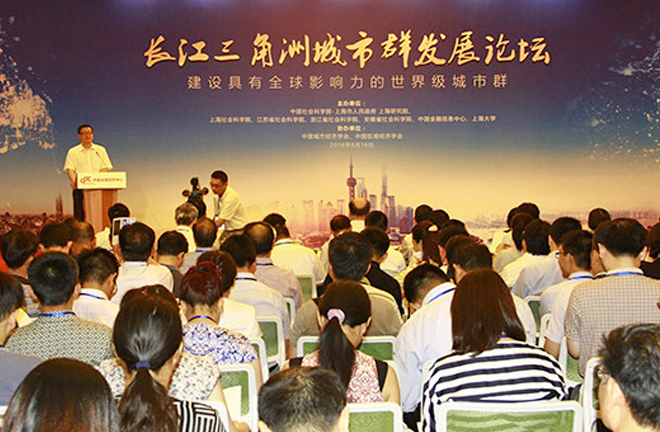World-class urban cluster to rise in Yangtze River Delta

Wang Weiguang,president of Chinese Academy of Social Sciences, delivers a speech at the Forum on the Development of Urban Cluster in Yangtze River Delta on Aug. 16 in Shanghai.
At a forum hosted by the Shanghai Academy on Aug. 16, government officials and academics continued work on plans to build a globally influential urban cluster in the Yangtze River Delta by 2030.
The forum builds on the guideline set out in a national plan to develop the urban cluster in the Yangtze River Delta released by the central government in June, which includes Shanghai and 25 prefecture-level cities in Jiangsu, Zhejiang and Anhui provinces. Though it accounts for about 2 percent of China’s land area, the delta generates more than 18 percent of the country’s GDP.
Wang Weiguang, president of Chinese Academy of Social Sciences, said the plan to build an urban cluster in the region represents an innovative attempt to change the economic growth model and cultivate new international competitive advantages against the backdrop of weak global growth and China’s transition into the “new normal.”
Through the development plan of a world-class urban cluster, the Yangtze River Delta may integrate and optimize the resources in this region and highlight the regional development advantages, which eventually may break the bottlenecks of resources for each individual city, Wang said.
As the core city of the urban cluster, Shanghai cannot develop without the support of and coordination with other cities from the cluster, said Yang Xiong, mayor of Shanghai. Shanghai should coordinate its planning together with other cities to advance and promote the pioneering and integrated development of this region, Yang said.
As one of the most-developed urban clusters in China, the region should establish an economic high ground of complementary high-tech industries by taking advantage of its human resources, innovation capacities and its unique position as the bridge between inland and global development, said Xu Kuangdi, vice-chairman of the Chinese People’s Political Consultative Conference (CPPCC).
Meanwhile, development should be people oriented, prioritizing ecological rehabilitation, protection of water resources and construction of urban green belts, Xu said.
The excessive concentration of population, resources and capital in China’s large cities has given rise to a host of urban problems. Small and medium-sized cities remain underdeveloped, while megacities are forming without proper planning, Xu said. Urban clusters with a coordinated development plan that emerged in the developed countries in 1950s, offered valuable experience in dealing with city problems, he said.
Each city is a node in the regional space and the urban cluster, and it is also the product of combined forces of aggregation and diffusion, which cannot be controlled by administrative measures, said Wang Qingwu, president of the Jiangsu Provincial Academy of Social Sciences.
Urban clusters have the potential to be highly competitive through the coordination of various economic factors among multiple cities, Wang said. Therefore, Yangtze River Delta urban cluster should pioneer in some measures on technological innovation and in promoting the integration of policies within the region on finance, tax, human resources, environment and some other issues, Wang Qingwu suggested.
Li Yu and Zha Jianguo are reporters at the Chinese Social Sciences Today.
